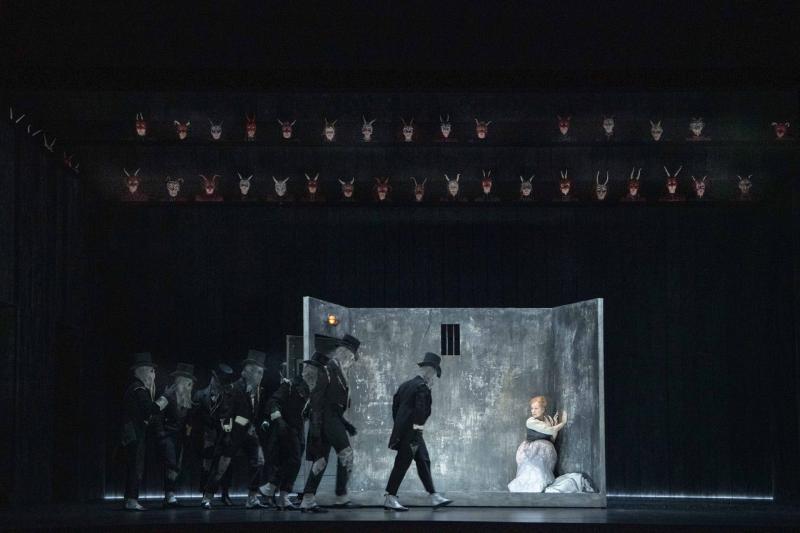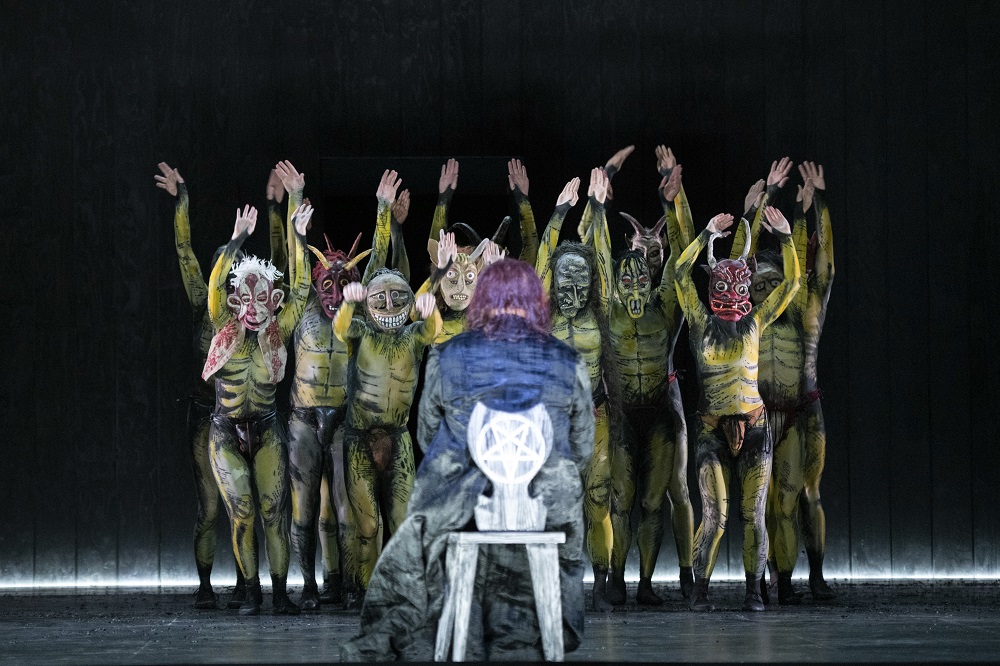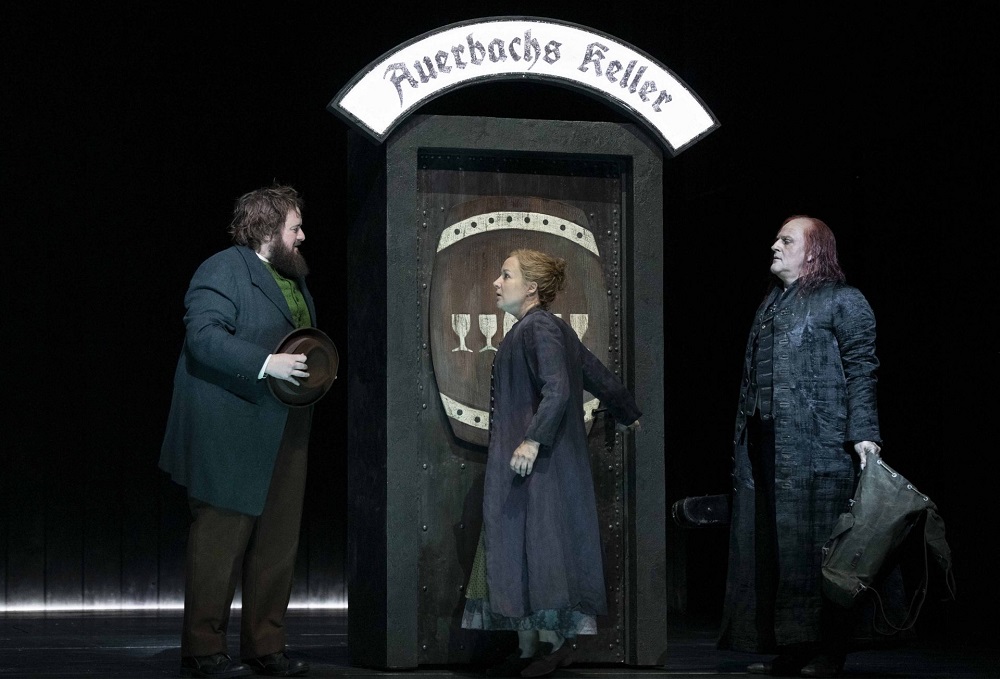La Damnation de Faust, Glyndebourne review – bleak and compelling makeover | reviews, news & interviews
La Damnation de Faust, Glyndebourne review – bleak and compelling makeover
La Damnation de Faust, Glyndebourne review – bleak and compelling makeover
Berlioz's Romantic Everyman seen in a sobering light

Mid-career, moving ever further away from composing for concert platform and church towards the stage, Berlioz found himself unsure where his take on Faust belonged. In the end he hedged his bets and titled it a "dramatic legend". Staging it as an opera, as he really wanted, requires the work of a theatrical plastic surgeon.
To raise the curtain on Glyndebourne this year, director Richard Jones wields the scalpel with audacity, finesse and disturbing realism. Extra lines of Goethe (adapted by Agathe Mélinand) give the introduction to Faust’s damnation a facelift. The well-worn Minuet for Will ’o’ the Wisps is neatly excised, then grafted on to the end as a knowing encore (pictured below, Christopher Purves as Mephistopheles with dancers), and in the tradition of danced conclusions to opera-ballets by the likes of Rameau and Gluck. Ingenious flashbacks use the peasants’ chorus and Hungarian march of Part 1 to show us Faust the unhappy child and hapless teacher at a military school. The squaddies recur throughout, and so does the presentation of the model anti-hero Faust as a failure – at philosophy, at love, at life.  Following a devout childhood, Berlioz had less and less time for organised paternalistic religion. Jones follows suit, and anyone expecting a pious Easter hymn to lift Faust from suicidal thoughts, or a radiantly redemptive apotheosis, will be disappointed (and hasn’t seen much of Jones’s work). The devil really does have the last laugh but for the most part this is a bleak and illuminating representation of human weakness and how ordinary people come to do terrible things.
Following a devout childhood, Berlioz had less and less time for organised paternalistic religion. Jones follows suit, and anyone expecting a pious Easter hymn to lift Faust from suicidal thoughts, or a radiantly redemptive apotheosis, will be disappointed (and hasn’t seen much of Jones’s work). The devil really does have the last laugh but for the most part this is a bleak and illuminating representation of human weakness and how ordinary people come to do terrible things.
Drawing “period” sonorities from the London Philharmonic Orchestra, conductor Robin Ticciati works with the hellish visions of Hyemi Shin’s set designs to emphasise the extremities of Berlioz’s weird and wonderful scoring. Some frenetic moments in the pit and on stage could be laid down to first-night nerves, though coordination with the upper reaches of the excellent Glyndebourne Chorus needs improving. As their master of ceremonies, presiding over his own theatre of cruelty, Mephistopheles was sung with terrific venom and sandpaper tone by Christopher Purves. Julie Boulianne captured Marguerite’s youth, beauty and vulnerability in her keenly focused mezzo no less than in her silent presence as an abused barmaid in Auerbach’s cellar (pictured below centre with Allan Clayton and Purves) – still the most overextended stretch of the piece – and the pregnant victim of Faust’s casual narcissism.  For me, the evening belonged to Allan Clayton’s Faust: an intensely sympathetic portrayal, all the more remarkable for the unsparing clarity of its insight, always elegantly sung and sustained with all the volume and subtlety one could wish for. His great hymn to nature, the point at which Faust most nearly touches the sublime, was over far too soon: a vision no less tantalising for its unprepossessing mise-en-scène of four bedraggled-looking trees. But hell awaits for this bumbling Everyman, a private hell of guilt and loneliness in the wake of Marguerite’s execution that no amount of reading Goethe will relieve.
For me, the evening belonged to Allan Clayton’s Faust: an intensely sympathetic portrayal, all the more remarkable for the unsparing clarity of its insight, always elegantly sung and sustained with all the volume and subtlety one could wish for. His great hymn to nature, the point at which Faust most nearly touches the sublime, was over far too soon: a vision no less tantalising for its unprepossessing mise-en-scène of four bedraggled-looking trees. But hell awaits for this bumbling Everyman, a private hell of guilt and loneliness in the wake of Marguerite’s execution that no amount of reading Goethe will relieve.
- The Damnation of Faust at Glyndebourne until 10 July
- Read more opera reviews on theartsdesk
rating
Explore topics
Share this article
The future of Arts Journalism
You can stop theartsdesk.com closing!
We urgently need financing to survive. Our fundraising drive has thus far raised £49,000 but we need to reach £100,000 or we will be forced to close. Please contribute here: https://gofund.me/c3f6033d
And if you can forward this information to anyone who might assist, we’d be grateful.

Subscribe to theartsdesk.com
Thank you for continuing to read our work on theartsdesk.com. For unlimited access to every article in its entirety, including our archive of more than 15,000 pieces, we're asking for £5 per month or £40 per year. We feel it's a very good deal, and hope you do too.
To take a subscription now simply click here.
And if you're looking for that extra gift for a friend or family member, why not treat them to a theartsdesk.com gift subscription?
more Opera
 The Railway Children, Glyndebourne review - right train, wrong station
Talent-loaded Mark-Anthony Turnage opera excursion heads down a mistaken track
The Railway Children, Glyndebourne review - right train, wrong station
Talent-loaded Mark-Anthony Turnage opera excursion heads down a mistaken track
 La bohème, Opera North review - still young at 32
Love and separation, ecstasy and heartbreak, in masterfully updated Puccini
La bohème, Opera North review - still young at 32
Love and separation, ecstasy and heartbreak, in masterfully updated Puccini
 Albert Herring, English National Opera review - a great comedy with depths fully realised
Britten’s delight was never made for the Coliseum, but it works on its first outing there
Albert Herring, English National Opera review - a great comedy with depths fully realised
Britten’s delight was never made for the Coliseum, but it works on its first outing there
 Carmen, English National Opera review - not quite dangerous
Hopes for Niamh O’Sullivan only partly fulfilled, though much good singing throughout
Carmen, English National Opera review - not quite dangerous
Hopes for Niamh O’Sullivan only partly fulfilled, though much good singing throughout
 Giustino, Linbury Theatre review - a stylish account of a slight opera
Gods, mortals and monsters do battle in Handel's charming drama
Giustino, Linbury Theatre review - a stylish account of a slight opera
Gods, mortals and monsters do battle in Handel's charming drama
 Susanna, Opera North review - hybrid staging of a Handel oratorio
Dance and signing complement outstanding singing in a story of virtue rewarded
Susanna, Opera North review - hybrid staging of a Handel oratorio
Dance and signing complement outstanding singing in a story of virtue rewarded
 Ariodante, Opéra Garnier, Paris review - a blast of Baroque beauty
A near-perfect night at the opera
Ariodante, Opéra Garnier, Paris review - a blast of Baroque beauty
A near-perfect night at the opera
 Cinderella/La Cenerentola, English National Opera review - the truth behind the tinsel
Appealing performances cut through hyperactive stagecraft
Cinderella/La Cenerentola, English National Opera review - the truth behind the tinsel
Appealing performances cut through hyperactive stagecraft
 Tosca, Royal Opera review - Ailyn Pérez steps in as the most vivid of divas
Jakub Hrůša’s multicoloured Puccini last night found a soprano to match
Tosca, Royal Opera review - Ailyn Pérez steps in as the most vivid of divas
Jakub Hrůša’s multicoloured Puccini last night found a soprano to match
 Tosca, Welsh National Opera review - a great company reduced to brilliance
The old warhorse made special by the basics
Tosca, Welsh National Opera review - a great company reduced to brilliance
The old warhorse made special by the basics
 BBC Proms: The Marriage of Figaro, Glyndebourne Festival review - merriment and menace
Strong Proms transfer for a robust and affecting show
BBC Proms: The Marriage of Figaro, Glyndebourne Festival review - merriment and menace
Strong Proms transfer for a robust and affecting show
 BBC Proms: Suor Angelica, LSO, Pappano review - earthly passion, heavenly grief
A Sister to remember blesses Puccini's convent tragedy
BBC Proms: Suor Angelica, LSO, Pappano review - earthly passion, heavenly grief
A Sister to remember blesses Puccini's convent tragedy

Add comment